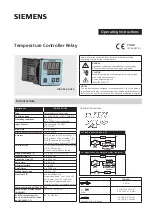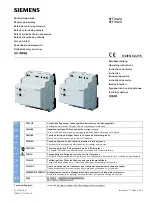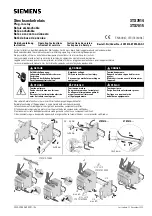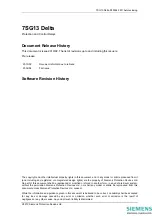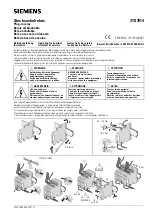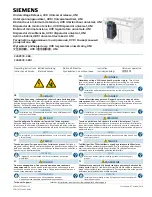
I.L. 40-386.3
(10/94)
2-21
system security. For a fault which can be detected by relays at two terminals,
AND-55 logic can be satisfied, then pilot trip will be performed via the logic in
the usual way.
2.5.6
Weakfeed Trip Application
a. Block/Weakfeed
The logic for a weakfeed terminal is not required for the (Blocking) system be-
cause the (Blocking) system requires no permissive trip signal from the remote
end, even though the remote end is a weakfeed terminal. The strong end has
no problem tripping for an internal fault. The weak end is usually assumed ei-
ther as a “no feed” source, for which it does not need to trip on an internal
fault, or it can pilot trip sequentially.
NOTE:
Refer to Figure 2-24
, logic AND-41B and OR-41C, Weakfeed should be
set to YES if OS Block is set to YES and this terminal may become a
weak condition.
For the bench test, at the conditions of V = 0 and I = 0, the carrier key-
ing contacts will be closed for the settings of OS Block = YES and Weak-
feed = NO. In an actual system, 52b will be applied to OR41C, because
of V = 0 and I = 0, and the carrier keying signal will not be sent.
b. PUTT/Weakfeed
The logic for a weakfeed terminal is not required for the PUTT system. Because
the PUTT system uses underreaching relay(s) only for pilot trip keying, it is im-
possible to apply this scheme to protect a system which may have weakfeed
condition.
c. POTT/ Weakfeed
For POTT and unblocking schemes, at the weak source terminal, the Zone3Ø
/Z3G distance relays should be set for reverse-looking, and the undervoltage
units (LVA, LVB, LVC) should be used. The basic operating principle of the
weakfeed trip logic for the POTT and simplified unblocking scheme is as
follows:
1)
Echo key for trip permission
(Figure 2-30)
On internal faults, the strong source end sends the trip (or unblocking) frequen-
cy signal to the weak end, and its pilot trip relay(s) will trip, once it receives echo
trip permission from the weak end. The pilot trip relay(s) at the weak end cannot
pick up due to not enough internal fault energy, and does not perform the nor-
mal keying function. With one weakfeed condition, when the weak end receives
a trip or unblocking signal, the output from the receiver operates the echo key
logic AND-65, providing both pilot relay (from OR-40) and reverse-looking relay
(from OR-41) do not pick-up, and if system disturbance is detected (
∆
V or
∆
I).
Output of AND-65 will key the weak terminal transmitter to the trip or unblock-
ing frequency via OR-18, AND-35. On weak end reverse external fault, the strong
source end sends the trip (or unblocking) frequency signal to the weak end, and
its pilot trip relay(s) is waiting to receive the echo trip permission from the weak
end. However, at the weak end, the echo key logic AND-65 will not operate, and
because of the reverse looking relay operation, it sends no echo signal to the
strong end. Both the strong/weak ends will not trip on this external fault.
Summary of Contents for REL 301
Page 1: ......
Page 8: ......
Page 17: ...I L 40 386 3 1 10 10 94 2682F39 Sheet 1 of 2 Sub 2 Figure 1 2 REL 301 302 Layout Vertical...
Page 18: ...I L 40 386 3 10 94 1 11 2682F39 Sheet 2 of 2 Sub 2 Figure 1 3 REL 301 302 Layout Horizontal...
Page 19: ......
Page 20: ......
Page 44: ......
Page 46: ......
Page 48: ......
Page 49: ......
Page 51: ......
Page 53: ......
Page 54: ......
Page 55: ......
Page 56: ......
Page 57: ......
Page 60: ......
Page 62: ...I L 40 386 3 10 94 2 41 Figure 2 32 CO 2 Curve Characteristics 619596 Sub 2...
Page 63: ...I L 40 386 3 2 42 10 94 Figure 2 33 CO 5 Curve Characteristic 619597 Sub 2...
Page 64: ...I L 40 386 3 10 94 2 43 Figure 2 34 CO 6 Curve Characteristic 619598 Sub 2...
Page 65: ...I L 40 386 3 2 44 10 94 Figure 2 35 CO 7 Curve Characteristic 619599 Sub 2...
Page 66: ...I L 40 386 3 10 94 2 45 Figure 2 36 CO 8 Curve Characteristic 619600 Sub 2...
Page 67: ...I L 40 386 3 2 46 10 94 Figure 2 37 CO 9 Curve Characteristic 619601 Sub 2...
Page 68: ...I L 40 386 3 10 94 2 47 Figure 2 38 CO 11 Curve Characteristic 619602 Sub 2...





































